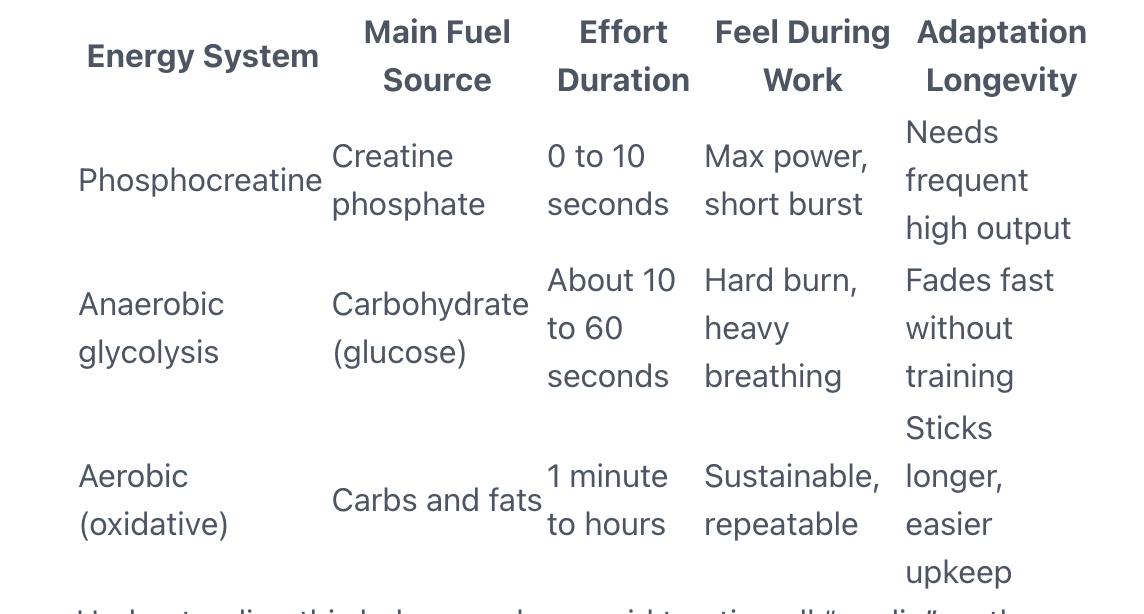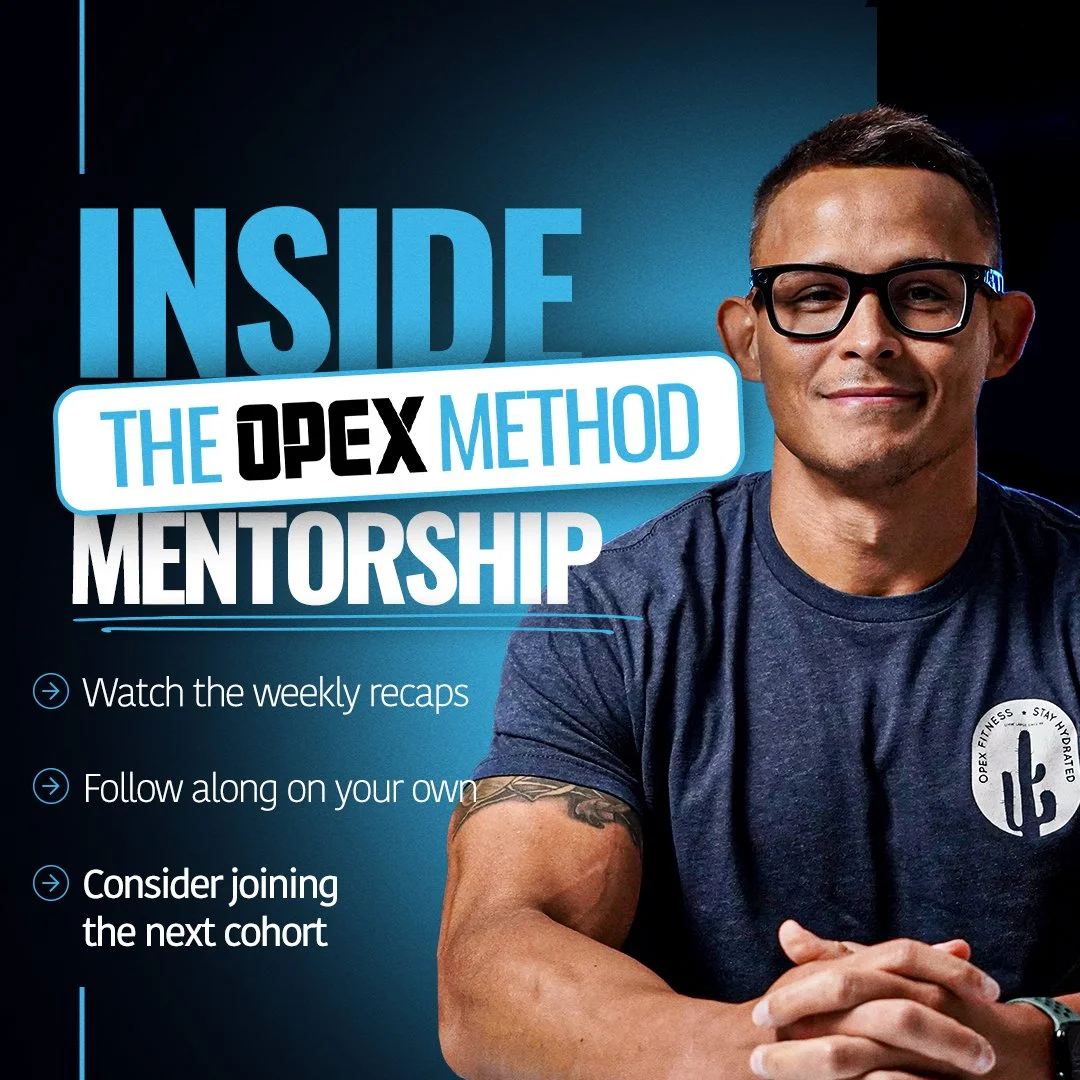Inside the OPEX Method Mentorship Week 5: Anaerobic Training, “Pain,” And Better Coaching
This blog series will document the 10 week experience of Dr. David Skolnik as he goes through the OPEX Method Mentorship. Follow along as we add to this blog each week.
Week 5: Anaerobic Training, “Pain,” And Better Coaching
If you coach people for a living, you already know that knowledge is only as good as what you do with it. Learning new systems is great, but the real test is simple: do your clients get better, and does your coaching business grow because of it?
That is exactly what is happening after going through Week 4 and Week 5 of the OPEX Method Mentorship. Week 4 focused on aerobic training and cardiovascular health. Week 5 moved into anaerobic work, the short and intense “OPEX pain” that most people think of as conditioning.
This post walks through how that education is already changing real client programs, what actually goes on during painful anaerobic work, who really needs it, and how often to use it without wrecking people in the process.
Turning Aerobic Education Into Real Client Results
The first big shift came from Week 4, which was all about aerobic training, OPEX sustain work, and cardiovascular progress that lasts.
As a coach, learning is nice. But nothing beats being able to say, “I used this framework and signed two new clients this week because of it.” That is exactly what happened.
One new client was a perfect example. She lifts six days per week and loves strength work. But she openly admitted she had a huge blind spot.
She avoids cardio.
The longer the effort, the more she puts it off.
She wanted someone to hold her accountable and give her a clear plan.
Because of the OPEX aerobic training framework, it was easy to lay out a plan that felt structured, not random.
How Her Aerobic Plan Came Together
Here is how her 12 week structure looks at a high level:
Undulating periodization for strength: Strength training volume and intensity shift over time, rather than staying flat.
On strength focused weeks: One multimodal aerobic day. Think mixed movements, different patterns, and sustainable efforts.
On higher volume hypertrophy weeks: One monostructural aerobic session. Think single modality, like a rower or bike, at planned intensities.
We also added:
Simple benchmarks to test along the way.
Clear progressions over 12 weeks.
Ways to keep things fun and varied, without losing the purpose.
All of this came straight out of the aerobic training concepts from the OPEX Method Mentorship. Because the framework was solid, the client felt confident, and so did the coach presenting it.
She was excited, said it was exactly what she needed, and starts next week.
Supporting Endurance And Ultra Endurance Athletes Better
This upgrade is not only helping new clients. It is also changing how existing endurance and ultra endurance clients are coached.
Before, strength work might have been the main area of focus, with “some cardio” suggested on the side. Now there are clearer structures for:
Where aerobic intervals fit.
How to support long events with better aerobic capacity.
How to line up strength work with endurance blocks so they do not fight each other.
That makes the coach more valuable for:
Runners and cyclists.
Athletes doing long events.
Clients who simply want better heart health and stamina.
In simple terms, better education is improving both performance and the business side of coaching.
If you want to see how OPEX structures their teaching for coaches, you can look at the OPEX Method coaching education curriculum.
Week 5: What “OPEX Pain” Really Is
Week 5 turned the spotlight on anaerobic training, often labeled “OPEX pain.” This is not your easy zone 2 cardio. This is the kind of work that leaves your legs on fire.
Think:
10 to 15 seconds on an Assault Bike at 95 to 100 percent effort.
All out sprints.
Short work bouts where your body feels like it is filling with acid.
Most people call that feeling “lactic acid burn.” The truth is a bit different, but just as unpleasant.
What Is Going On Inside Your Muscles?
Here is the simple version of what happens during hard anaerobic work:
At the start of an all out effort, your body uses the phosphocreatine system. This is your fastest energy system and uses stored creatine phosphate. It supports only a few seconds of true max effort.
As that system runs out, your body shifts to anaerobic glycolysis. This breaks down carbs for energy without using oxygen.
During this process, your body produces lactate and hydrogen ions. The hydrogen ions, not lactate itself, are what make your muscles feel like they are burning.
You are not working long enough to switch fully to your aerobic, oxygen driven system, but you have already outrun your phosphocreatine system. You are stuck in a painful “in between” zone.
Your body tries to buffer those hydrogen ions. When it falls behind, you feel that classic “I might throw up” sensation on the bike or track.
This is why that style of training feels so rough, even if the total work time is short.
The Main Lesson: Most People Do Not Need Much Anaerobic Work
The biggest takeaway from Week 5 is simple. Most general population clients do not need to live in this zone.
Anaerobic training makes sense for:
Competitive athletes.
First responders.
Military members preparing for tests.
Anyone with a specific event on a specific date that demands short, intense output.
For them, you can program a short block of anaerobic work to drive a clear adaptation. But that adaptation does not last forever.
Once they stop training it, it fades. That is very different from aerobic gains, which hang around longer and are easier to maintain.
Comparing Energy Systems At A Glance
Here is a quick view of how these energy systems differ.
Understanding this helps coaches avoid treating all “cardio” as the same thing.
How Often Should You Program Anaerobic Blocks?
Knowing that anaerobic adaptations fade fast and that sessions feel terrible, it makes sense to be very selective.
For a well rounded “functional” athlete who wants to keep some sharpness across all systems, a simple guideline looks like this:
Hit 2 to 4 short anaerobic blocks per year.
Each block lasts about 4 weeks.
Aim for 1 to 2 anaerobic sessions per week during that time.
That is enough to remind the body, “You still have this gear,” without beating clients into the ground.
Key ideas to keep front of mind:
The sessions are not sustainable. Clients cannot live here year round without trouble.
The adaptation is not sustainable unless you keep training it.
The block needs a clear start and end, with a specific test, event, or sport in mind.
Good examples of where these blocks fit:
Leading into military or law enforcement physical readiness tests.
Preseason for field or court sports.
Before a competition that has short bursts at very high power.
Without that context, most clients are better served building a big aerobic base and strength first.
Getting The Same “Feeling” With Aerobic Intervals
Many clients think conditioning has to mean total suffering. They think of it as:
Assault bike intervals that make them want to throw up.
Workouts that leave them lying on the floor for 10 minutes afterward.
Here is the interesting part. You can create hard, satisfying conditioning with well designed, intense aerobic intervals instead.
These intervals:
Feel challenging and “spicy.”
Deliver sustainable progress across weeks and months.
Do not hijack long term health or short term well being the way careless anaerobic work can.
This is one of the biggest mindset shifts from Week 4 and Week 5 together. Coaches can give people the feeling they want from conditioning, without pushing clients into unsustainable zones all year.
Use intense aerobic intervals for most of the year, then touch anaerobic work on purpose and in short blocks.
Why This Education Feels Different For An Experienced Coach
Movement assessment, strength programming, and resistance training have been part of this coach’s toolkit for over a decade. Those skills get used with every single client.
Energy systems, on the other hand, had not been revisited in a deep way since an exercise science program about 15 years ago. There had been some exposure, but not with this level of clarity, structure, or immediate use.
That is what makes the OPEX Method feel so helpful right now.
There are real clients who need better aerobic and anaerobic planning.
New tools from the mentorship can be applied right away.
Seeing those tools work in real time is what makes the learning stick.
If you want to explore similar tools and templates, the free coaching resources from OPEX Fitness and the CoachRx free resources page are good places to start.
Bringing It All Together
The last two weeks of the OPEX Method Mentorship highlight a simple truth. To be a better coach, you need more than strong opinions about “conditioning.” You need a real framework for energy systems training that you can defend and apply.
Key points to keep in mind:
Aerobic training builds long lasting progress and carries over to health, performance, and life.
Anaerobic training has a place, but mostly for those with clear, high demand events or jobs.
Most people need far more structured aerobic work and far less random “bike until you want to puke” sessions.
Short, focused anaerobic blocks a few times per year are enough for many functional athletes.
If you coach, ask yourself: are you programming conditioning with this level of intent, or are you just chasing tired and sweaty? Getting clear on that answer can change your clients’ results and the future of your coaching business.
Next Steps
Become A Professional Coach.
Wherever you are on your coaching journey, learn a repeatable and proven system to simplify program design and build a sustainable career. See how the OPEX Method Mentorship can help you find your version of success as a professional coach.
Elevate Your Coaching Business
CoachRx empowers fitness coaches to excel in program design, nurture client relationships, and scale their businesses with unparalleled efficiency and insight. Discover why CoachRx is the preferred choice for fitness coaches seeking to differentiate and deliver exceptional services.
Continue To Learn & Grow
Whether you want to write better training programs, increase your knowledge of nutrition & lifestyle protocols, or work on your coaching business, LearnRx has got you covered with courses, playlists, tools, and resources on demand. New content added monthly.



